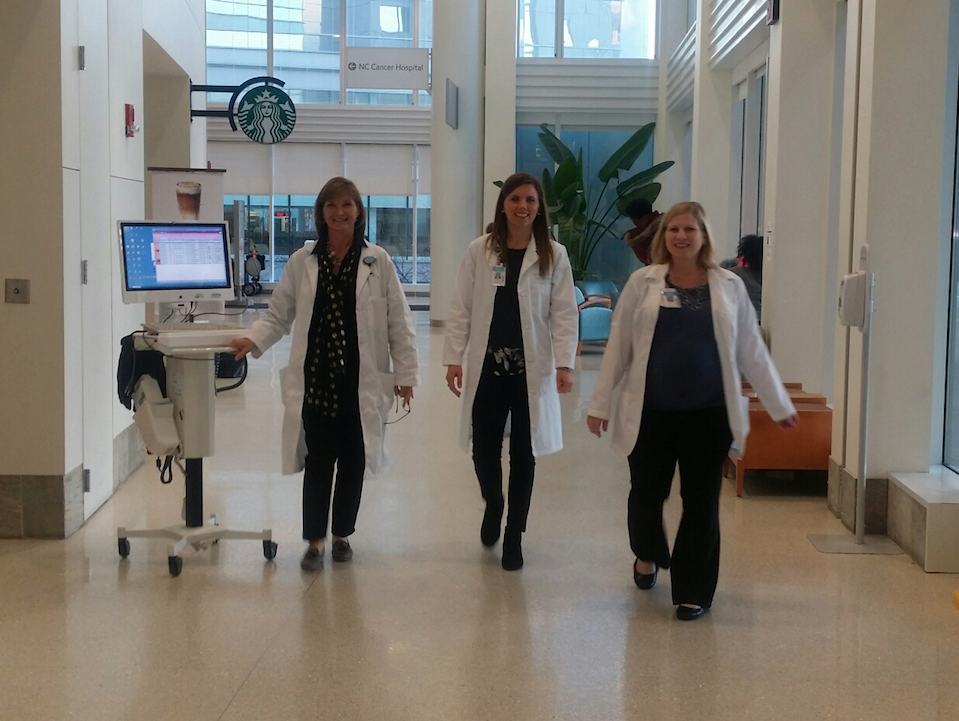UNC Department of Medicine Innovates Admissions Hub, Medical Admitting Officers Set Pace for Inpatient Care.

Like the maestro at a podium, the medicine admitting officer (MAO) is vital to every Medicine patient arrival at UNC Medical Center. Before a patient is admitted, he or she is matched with a physician for the specific care that will be needed. A coordinated approach isn’t new. The MAO has always been an integral part of admission operations, except up until now, it was carried out by a rotating clinical team. What is new is a service integration that puts nurses who understand patient flow in a medical admitting role. This allows primary care physicians and hospitalist physicians to do what they do best.
“Timing is everything when it comes to patient care,” says Dr. Ron Falk, Chairman of UNC’s Department of Medicine, who saw an opportunity to redesign medicine admissions. “By placing a nurse with movement experience in this role, we are transforming the delivery of health care at UNC’s Medical Center. The promise of a coordinated admission means we can create better patient experiences and ultimately better care.”
Joanne Lowry, RN, BSN, MSBC, was the first MAO, joined in November by Susan Zepeda, RN, BSN, CCRN, and Stephanie Briley, RN, BSN, CCRN. What she discovered was a system that was often misunderstood by nursing and house supervisors. Prior to this time, it could take several hours to coordinate an admission from a clinic or ED provider. All the while physicians were trying to keep busy clinic schedules going and caring for multiple patients.
“A provider made multiple calls to find a team that had space, to get the referral to the admitting office and to call house support for a bed,” says Lowry who worked with Glenn Spivak, Vice President of Operational Efficiency, to create the new process. “Patients were being admitted and assigned to capped teams. We realized patients needed to be paired to physicians prior to being admitted and they needed to be regionalized. Otherwise teams were rounding on too many units and this didn’t make sense.”
Now, regionalization is achieved by placing patients on teams that will have capacity and bed space. As Zepeda explains, it provides an opportunity to coordinate patients with services they need.
“Placing a patient with Welt-General Medicine wouldn’t make sense without a bed on 8 Bedtower,” says Zepeda. “Therefore, we consider sister team Burnett-General Medicine to admit to 3 West where we know we will have discharges and bed availability. In doing so, we are driving patients who need specialty care to those services, such as the renal transplant to the nephrology service, or the lung transplant to the pulmonary service.”
A dashboard view of movement enables MAOs to triage patients to the right care team at the right time, monitoring team and bed availability, and patient discharges, while simultaneously tracking flow from the cath lab, VIR and GI procedures, the Emergency Department, and outside transfers. They also coordinate movement along the nine-mile corridor, especially when the main campus has capacity constraints, directly admitting to the Hillsborough campus and arranging transfers.
Briley says MAOs even carry the hospitalist pager and this has a positive impact on patient care.
“We field calls for the hospitalists and residents so that they can concentrate on admitting. This allows the admitting hospitalist and residents to work with fewer interruptions and patients have their full attention.”
The new care model has been favorably received and other hospital services have taken notice. Rex Hospital is even coming to shadow.
“I appreciate the work our physicians do so much more than ever before,” said Lowry. “We all agree, the Department of Medicine–Dr. Berkowitz, Dr. Falk, Dr. Bynum, Janet Hadar and the Medicine chiefs—have given us an incredible amount of assistance. I’ve never before experienced this culture of professional support.”